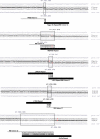Genotype-phenotype correlations in patients with retinoblastoma and interstitial 13q deletions
- PMID: 21505449
- PMCID: PMC3179359
- DOI: 10.1038/ejhg.2011.58
Genotype-phenotype correlations in patients with retinoblastoma and interstitial 13q deletions
Abstract
Patients with an interstitial 13q deletion that contains the RB1 gene show retinoblastoma and variable clinical features. Relationship between phenotypic expression and loss of specific neighboring genes are unresolved, yet. We obtained clinical, cytogenetic and molecular data in 63 patients with an interstitial 13q deletion involving RB1. Whole-genome array analysis or customized high-resolution array analysis for 13q14.11q14.3 was performed in 38 patients, and cytogenetic analysis was performed in 54 patients. Deletion sizes ranged between 4.2 kb and more than 33.43 Mb; breakpoints were non-recurrent. Sequence analysis of deletion junctions in five patients revealed microhomology and insertion of 2-34 base pairs suggestive of non-homologous end joining. Milder phenotypic expression of retinoblastoma was observed in patients with deletions larger than 1 Mb, which contained the MED4 gene. Clinical features were compared between patients with small (within 13q14), medium (within 13q12.3q21.2) and large (within 13q12q31.2) deletions. Patients with a small deletion can show macrocephaly, tall stature, obesity, motor and/or speech delay. Patients with a medium deletion show characteristic facial features, mild to moderate psychomotor delay, short stature and microcephaly. Patients with a large deletion have characteristic craniofacial dysmorphism, short stature, microcephaly, mild to severe psychomotor delay, hypotonia, constipation and feeding problems. Additional features included deafness, seizures and brain and heart anomalies. We found no correlation between clinical features and parental origin of the deletion. Our data suggest that hemizygous loss of NUFIP1 and PCDH8 may contribute to psychomotor delay, deletion of MTLR1 to microcephaly and loss of EDNRB to feeding difficulties and deafness.
Figures




Similar articles
-
Fine mapping of whole RB1 gene deletions in retinoblastoma patients confirms PCDH8 as a candidate gene for psychomotor delay.Eur J Hum Genet. 2013 Apr;21(4):460-4. doi: 10.1038/ejhg.2012.186. Epub 2012 Aug 22. Eur J Hum Genet. 2013. PMID: 22909775 Free PMC article.
-
13q Deletion Syndrome Involving RB1: Characterization of a New Minimal Critical Region for Psychomotor Delay.Genes (Basel). 2021 Aug 26;12(9):1318. doi: 10.3390/genes12091318. Genes (Basel). 2021. PMID: 34573300 Free PMC article.
-
Five patients with novel overlapping interstitial deletions in 8q22.2q22.3.Am J Med Genet A. 2011 Aug;155A(8):1857-64. doi: 10.1002/ajmg.a.34072. Epub 2011 Jul 7. Am J Med Genet A. 2011. PMID: 21739578
-
Chromosome deletions in 13q33-34: report of four patients and review of the literature.Am J Med Genet A. 2008 Feb 1;146A(3):337-42. doi: 10.1002/ajmg.a.32127. Am J Med Genet A. 2008. PMID: 18203171 Review.
-
Two Cases with Ring Chromosome 13 at either End of the Phenotypic Spectrum.Cytogenet Genome Res. 2017;153(4):175-180. doi: 10.1159/000486775. Epub 2018 Mar 9. Cytogenet Genome Res. 2017. PMID: 29518772 Review.
Cited by
-
Recurrent Sporadic Bilateral Retinoblastoma in a Child with 13q Deletion Syndrome.Cureus. 2020 Jan 10;12(1):e6618. doi: 10.7759/cureus.6618. Cureus. 2020. PMID: 32064198 Free PMC article.
-
Spectrum of RB1 Germline Mutations and Clinical Features in Unrelated Chinese Patients With Retinoblastoma.Front Genet. 2020 Mar 11;11:142. doi: 10.3389/fgene.2020.00142. eCollection 2020. Front Genet. 2020. PMID: 32218800 Free PMC article.
-
Fine mapping of whole RB1 gene deletions in retinoblastoma patients confirms PCDH8 as a candidate gene for psychomotor delay.Eur J Hum Genet. 2013 Apr;21(4):460-4. doi: 10.1038/ejhg.2012.186. Epub 2012 Aug 22. Eur J Hum Genet. 2013. PMID: 22909775 Free PMC article.
-
A female patient with retinoblastoma and severe intellectual disability carrying an X;13 balanced translocation without rearrangement in the RB1 gene: a case report.BMC Med Genomics. 2019 Dec 5;12(1):182. doi: 10.1186/s12920-019-0640-2. BMC Med Genomics. 2019. PMID: 31806026 Free PMC article.
-
Participation in an occupational therapy referral program for children with retinoblastoma.J Pediatr Rehabil Med. 2016 May 31;9(2):117-24. doi: 10.3233/PRM-160372. J Pediatr Rehabil Med. 2016. PMID: 27285804 Free PMC article. Clinical Trial.
References
-
- Albrecht P, Ansperger-Rescher B, Schüler A, Zeschnigk M, Gallie B, Lohmann DR. Spectrum of gross deletions and insertions in the RB1 gene in patients with retinoblastoma and association with phenotypic expression. Hum Mutat. 2005;26:437–445. - PubMed
-
- Bunin GR, Emanuel BS, Meadows AT, Buckley JD, Woods WG, Hammond GD. Frequency of 13q abnormalities among 203 patients with retinoblastoma. J Natl Cancer Inst. 1989;81:370–374. - PubMed
-
- Matsunaga E. Retinoblastoma: host resistance and 13q- chromosomal deletion. Hum Genet. 1980;56:53–58. - PubMed
-
- Motegi T, Kaga M, Yanagawa Y, et al. A recognizable pattern of the midface of retinoblastoma patients with interstitial deletion of 13q. Hum Genet. 1983;64:160–162. - PubMed
Publication types
MeSH terms
Supplementary concepts
LinkOut - more resources
Full Text Sources
Miscellaneous

